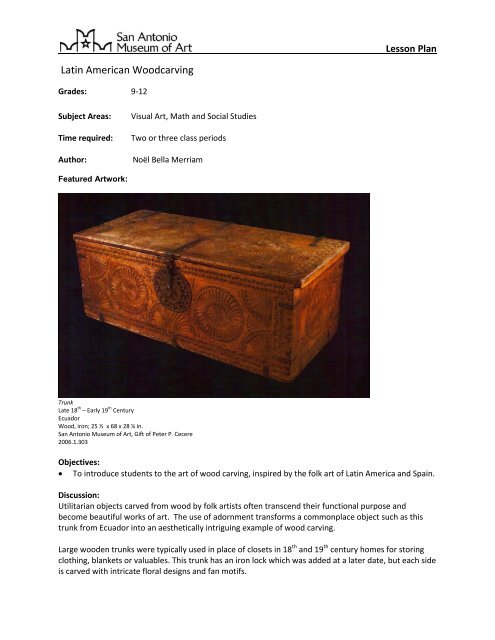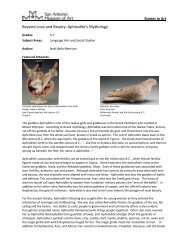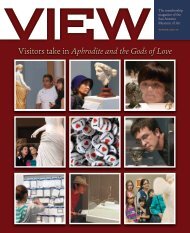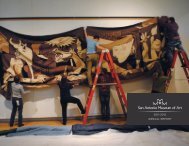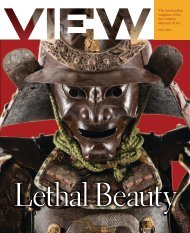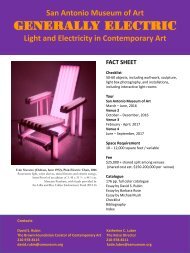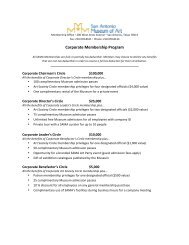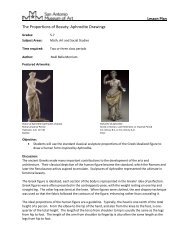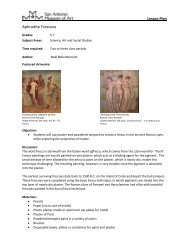Latin American Wood Carving - San Antonio Museum of Art
Latin American Wood Carving - San Antonio Museum of Art
Latin American Wood Carving - San Antonio Museum of Art
You also want an ePaper? Increase the reach of your titles
YUMPU automatically turns print PDFs into web optimized ePapers that Google loves.
ple<br />
Lesson Plan<br />
<strong>Latin</strong> <strong>American</strong> <strong>Wood</strong>carving<br />
Grades: 9-12<br />
Subject Areas:<br />
Time required:<br />
Author:<br />
Visual <strong>Art</strong>, Math and Social Studies<br />
Two or three class periods<br />
Noёl Bella Merriam<br />
Featured <strong>Art</strong>work:<br />
Trunk<br />
Late 18 th – Early 19 th Century<br />
Ecuador<br />
<strong>Wood</strong>, iron; 25 ½ x 68 x 28 ¼ in.<br />
<strong>San</strong> <strong>Antonio</strong> <strong>Museum</strong> <strong>of</strong> <strong>Art</strong>, Gift <strong>of</strong> Peter P. Cecere<br />
2006.1.303<br />
Objectives:<br />
To introduce students to the art <strong>of</strong> wood carving, inspired by the folk art <strong>of</strong> <strong>Latin</strong> America and Spain.<br />
Discussion:<br />
Utilitarian objects carved from wood by folk artists <strong>of</strong>ten transcend their functional purpose and<br />
become beautiful works <strong>of</strong> art. The use <strong>of</strong> adornment transforms a commonplace object such as this<br />
trunk from Ecuador into an aesthetically intriguing example <strong>of</strong> wood carving.<br />
Large wooden trunks were typically used in place <strong>of</strong> closets in 18 th and 19 th century homes for storing<br />
clothing, blankets or valuables. This trunk has an iron lock which was added at a later date, but each side<br />
is carved with intricate floral designs and fan motifs.
Lesson Plan<br />
<strong>Latin</strong> <strong>American</strong> <strong>Wood</strong>carving<br />
Materials:<br />
<strong>Wood</strong> carving tool sets (http://www.righttoolusa.com/p/Yasutomo-Niji-<strong>Wood</strong>carving-Set-Of-12-<br />
10692587.html?gclid=CPTy69TBhrYCFdSnPAodQkAA0A)<br />
3”x 3” squares <strong>of</strong> bass wood (larger sizes can be substituted)<br />
3” x 3” squares <strong>of</strong> paper for designs<br />
Pencils<br />
Erasers<br />
Optional: long strips <strong>of</strong> wood attached to table 5” from outer edge with duct tape to use as<br />
“secure holds” for safety and stability. If using larger pieces <strong>of</strong> wood (> 6” square), this may not<br />
be necessary. Installing ‘secure holds’ takes time - do before class.<br />
Process:<br />
1. Introduce the art <strong>of</strong> wood carving and discuss the images <strong>of</strong> wooden folk art from <strong>Latin</strong> America<br />
and Spain with the students.<br />
2. Review the three basic types <strong>of</strong> carving tools (gouge, v-tools, and chisels)<br />
3. Review the safety procedures with the class:<br />
Always push the blade away from your body while carving<br />
Keep both hands on your tool, with one hand in contact with the table.<br />
Cut horizontally across the wood, carving out a shallow amount each time.<br />
4. If using guards, attach to tables and demonstrate how to position the wood square between the<br />
guard and the edge <strong>of</strong> the table. The guard will help to keep the wood from slipping forward<br />
while it is being carved.<br />
5. Review the safety procedures with the class:<br />
Always hold the blade <strong>of</strong> each tool facing away from your body<br />
Keep both hands on the handle side <strong>of</strong> the blade<br />
Cut horizontally across the wood, carving out a shallow amount each time.<br />
6. Teach the ‘high-angle’ and ‘low-angle’ tool grips, and review basic carving skills for each.<br />
7. Using a pencil, students will draw a simple design on their paper, and then transfer their design<br />
to the square <strong>of</strong> wood. Alternatively, they may sketch their design directly onto the wood using<br />
a template, or freehand sketch.<br />
8. Demonstrate how to use each tool.<br />
9. Allow students to carve their design into the wood. Monitor them closely during this process,<br />
reviewing correct procedures as necessary.<br />
10. Finished wood carvings can be painted or stained to seal in the wood.<br />
Resources:<br />
<strong>Wood</strong>carving Course & Reference Manual: A Beginner’s Guide to Traditional Techniques, by Chris Pye<br />
<strong>Wood</strong>craft Store: http://www.woodcraft.com/stores/store.aspx?id=319<br />
TEKS<br />
§117.52. <strong>Art</strong>, Level I<br />
(c) Knowledge and skills.(1) Perception. The student develops and organizes ideas from the environment .The student is expected to:(A)<br />
illustrate ideas for artworks from direct observation, experiences, and imagination; and (B) compare and contrast the use <strong>of</strong> art elements<br />
(color, texture, form, line, space, value) and art principles (emphasis, pattern, rhythm, balance, proportion, unity) in personal artworks<br />
and those <strong>of</strong> others, using vocabulary accurately. (2) Creative expression/performance. The student expresses ideas through original artworks,<br />
using a variety <strong>of</strong> media with appropriate skill. The student is expected to: (A) create visual solutions by elaborating on direct observation,<br />
experiences, and imagination; (B) create designs for practical applications; and (C) demonstrate effective use <strong>of</strong> art media and tools in design,<br />
drawing, painting, printmaking, and sculpture. (3) Historical/cultural heritage. The student demonstrates an understanding <strong>of</strong> art history and<br />
culture as records <strong>of</strong> human achievement. The student is expected to: (A) compare and contrast historical and contemporary styles, identifying<br />
general themes and trends; (B) describe general characteristics in artworks from a variety <strong>of</strong> cultures;
Lesson Plan<br />
<strong>Latin</strong> <strong>American</strong> <strong>Wood</strong>carving<br />
_ _ _ _ _ _ _ _ _ _ _ _ _ _ _ _ _ _ _ _ _ _ _ _ _ _ _ _ _ _ _ _ _ _ _ _ _ _ _ _ _ _ _ _ _ _ _ _ _ _ _ _ _<br />
SAMA Wants Your Feedback!<br />
Title <strong>of</strong> Project/Lesson:_________________________________________________________________<br />
1. Was this Project/Lesson used as a pre-visit, post-visit, or classroom only? (circle one)<br />
2. Would you recommend this Project/Lesson or use it again? Yes or No (circle one)<br />
3. Did you modify this Project/Lesson? If so, how? ___________________________________________<br />
Subject: _____________________Grade level:__________ E-mail:______________________________<br />
Additional comments: __________________________________________________________________<br />
Please mail, e-mail or fax to: <strong>San</strong> <strong>Antonio</strong> <strong>Museum</strong> <strong>of</strong> <strong>Art</strong> Education Department · 200 West Jones Avenue<br />
Ave. · <strong>San</strong> <strong>Antonio</strong>, Texas 78215 Phone (210) 978-8100 · Fax (210) 978-8134 · education@samuseum.org


